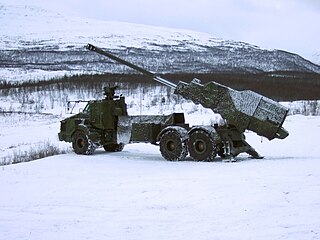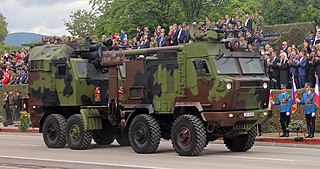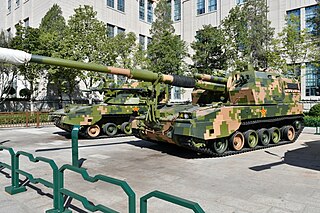
The M198 is a medium-sized, towed 155 mm artillery piece, developed for service with the United States Army and Marine Corps. It was commissioned to be a replacement for the World War II-era M114 155 mm howitzer. It was designed and prototyped at the Rock Island Arsenal in 1969 with firing tests beginning in 1970 and went into full production there in 1978. It entered service in 1979 and since then 1,600 units have been produced.

The M109 is an American 155 mm turreted self-propelled howitzer, first introduced in the early 1960s to replace the M44. It has been upgraded a number of times, most recently to the M109A7. The M109 family is the most common Western indirect-fire support weapon of maneuver brigades of armored and mechanized infantry divisions.

The Singapore Self-Propelled Howitzer 1 Primus is a self-propelled howitzer armed with a 155 mm howitzer. Developed jointly by the Singapore Armed Forces (SAF), Defence Science and Technology Agency (DSTA) and Singapore Technologies Kinetics, it was officially inducted to the Singapore Artillery in 2004. Primus is derived from the Artillery motto In Oriente Primus.

The M777 howitzer is a towed 155 mm artillery piece in the howitzer class. It is used by the ground forces of Australia, Canada, Colombia, India, Saudi Arabia, Ukraine, and the United States. It was first used in combat during the War in Afghanistan.

The FH70 is a towed howitzer used by several nations.

The M101A1 howitzer is an artillery piece developed and used by the United States. It was the standard U.S. light field howitzer in World War II and saw action in both the European and Pacific theaters and during the Korean War. Entering production in 1941, it quickly gained a reputation for accuracy and a powerful punch. The M101A1 fires 105 mm high explosive (HE) semi-fixed ammunition and has a range of 12,330 yards (11,270 m), making it suitable for supporting infantry.

The DANA (Dělo automobilní nabíjené automaticky is a wheeled self-propelled artillery piece. It is also known as the Samohybná Kanónová Húfnica vzor 77. It was designed by Konštrukta Trenčín and built by ZTS Dubnica nad Váhom in the former Czechoslovakia. Introduced in the 1970s, it was the first wheeled 152 mm self-propelled artillery gun to enter service. It is based on a modified eight-wheel drive Tatra 815 chassis with excellent cross-country mobility. Currently it is in service with the Czech Republic, Libya, Poland, Georgia, Azerbaijan, Slovakia, and Ukraine.

Fälthaubits 77 or FH77 is a Swedish 155 mm howitzer, developed and manufactured by Bofors. It is also colloquially known as the Bofors gun in India. There were several versions, the original with a 38 calibre barrel and sliding block mechanism, the export version FH77 B version with a 39 calibre barrel and an interrupted ogival screw breech. For the demonstrator of the Archer Artillery System, some FH77A were modified into FH 77 AD L/45, while the series production were FH77Bs rebuilt into FH77 BW L/52. The carriage was also used for the KARIN, used in the Swedish coastal artillery.

The Archer Artillery System, or Archer – FH77BW L52, or Artillerisystem 08, is a Swedish self-propelled howitzer system. The main piece of the system is a fully automated 155 mm L52 (52-calibre-long) gun-howitzer and a M151 Protector remote-controlled weapon station mounted on a modified 6×6 chassis of the Volvo A30D all-terrain articulated hauler. The crew and engine compartment is armoured and the cab is fitted with bullet and fragmentation-resistant windows. The system also includes an ammunition resupply vehicle, a support vehicle, BONUS submunitions, and M982 Excalibur guided projectiles.

The 152 mm gun-howitzer M1955, also known as the D-20, is a manually loaded, towed 152 mm gun-howitzer artillery piece, manufactured in the Soviet Union during the 1950s. It was first observed by the West in 1955, at which time it was designated the M1955. Its GRAU index is 52-P-546.

The Nora B-52 is a 155 mm self-propelled howitzer developed by Military Technical Institute and manufactured by Yugoimport SDPR in Velika Plana, Serbia.

The PLZ-45 or Type 88 is a 155 mm self-propelled howitzer designed by Su Zhezi of 674 Factory, and developed by Norinco, 123 Factory, 127 Factory, 674 Factory and the Beijing Institute of Technology in the early 1990s for the export market. It is based on Norinco's Type 89 (PLL-01) 155 mm/45-calibre towed gun-howitzer.

The PLZ-05 or the Type 05 is a 155 mm self-propelled howitzer developed by the People's Liberation Army of China to replace the Type 59-1 130 mm towed gun and Type 83 152 mm self-propelled gun. The PLZ-05 was officially unveiled at the Military Museum of the Chinese People's Revolution to mark the 80th anniversary of the PLA in July 2007, and first entered service with the PLA in 2008.

The Hyundai WIA, formerly known as World Industries Ace is a member of the Hyundai Motor Group and is the second biggest automotive parts manufacturer in South Korea. As one of the core companies of Hyundai Motor Group, it is supplying automobile engines, modules, C.V Joint and 4WD systems to automobile companies such as Hyundai, Kia, and Genesis. In addition, it is in charge of manufacturing and selling FA facilities, various large-caliber artillery, aircraft parts, robots, and press device. The main customers who earn most of their sales are Hyundai, Kia, Genesis, and the Ministry of National Defense.

The HM-41 is an Iranian 155 mm howitzer based on the KH179, which was imported from South Korea during the Iran–Iraq War. It has a 155 mm/39 caliber barrel with a muzzle brake to lessen the recoil.

The Advanced Towed Artillery Gun System (ATAGS) is a towed 155 mm/52 calibre howitzer that is being developed for the Indian Army by Armament Research and Development Establishment (ARDE), Tata Advanced Systems and Kalyani Strategic Systems.
The PLL-01, also known as the WAC-021, is a type of 155 mm howitzer designed by Gerald Bull and built by Chinese defense manufacturer Norinco.

The 155 mm Howitzer Motor Carriage M41 was an American self-propelled artillery vehicle built on a lengthened M24 Chaffee tank chassis that was introduced at the end of the Second World War. Out of a planned run of 250, only 85 were produced before cancellation of the order at the end of 1945. The M41 went on to serve extensively in the Korean War, its success influencing the design of later U.S. self-propelled artillery. The type was retired after the conclusion of that conflict but went on to serve in the French Army from 1956 to 1972.
The PCL-181 is a Chinese truck-mounted, 155 mm self-propelled howitzer used by the People's Liberation Army Ground Force (PLAGF). The designation "PCL" is an acronym derived from pinyin.

The KH178 is a South Korean 105 mm 38 caliber towed howitzer. It was designed and developed by the Agency for Defense Development (ADD) for the Republic of Korea Armed Forces and manufactured by Hyundai WIA.



















